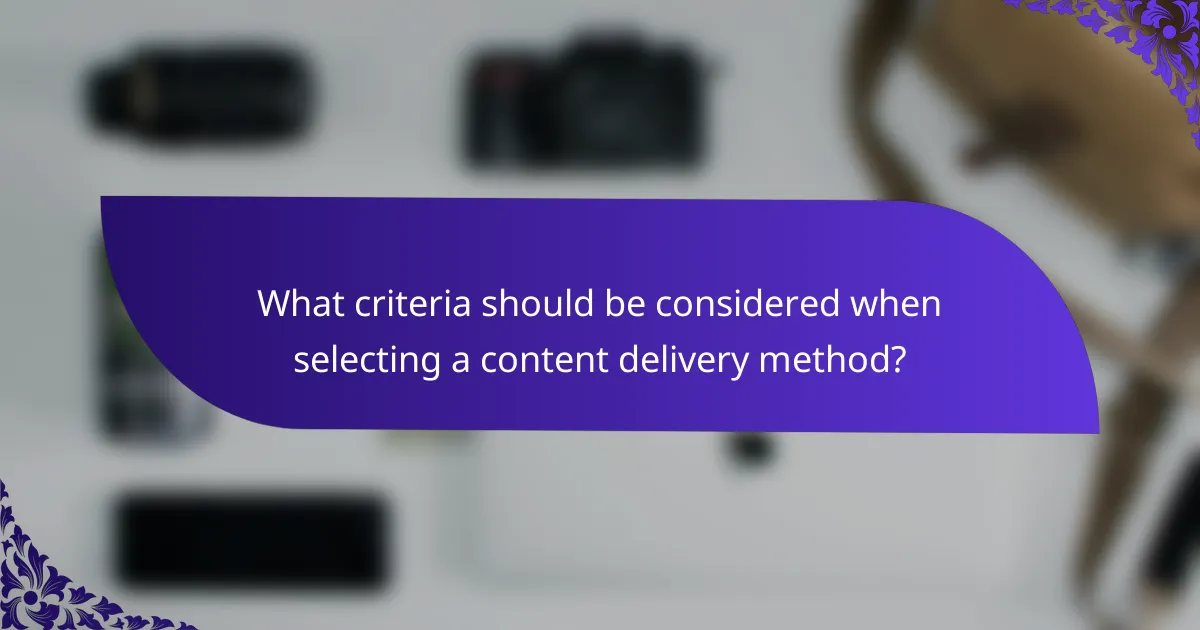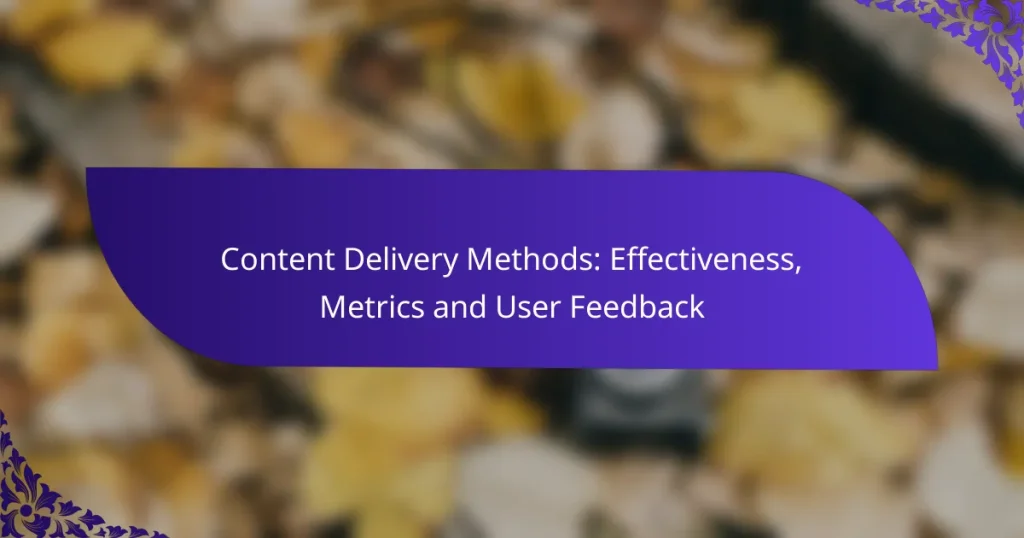In today’s digital landscape, selecting the right content delivery methods is essential for maximizing user engagement and satisfaction. Effective approaches such as streaming services, CDNs, and social media platforms offer distinct advantages, while metrics and user feedback play a critical role in refining these strategies. By leveraging insights from user interactions, organizations can tailor their content to better meet audience needs and preferences.

What are the most effective content delivery methods?
The most effective content delivery methods include streaming services, content delivery networks (CDNs), email newsletters, social media platforms, and webinars. Each method has unique strengths and considerations that can significantly impact user engagement and satisfaction.
Streaming services
Streaming services deliver content in real-time over the internet, allowing users to access videos, music, and live broadcasts instantly. Popular platforms like Netflix and Spotify utilize adaptive bitrate streaming to ensure smooth playback across various internet speeds.
When choosing a streaming service, consider factors like content variety, subscription costs, and user interface. Additionally, ensure that your internet connection can handle the required bandwidth, typically ranging from 3 Mbps for standard definition to 25 Mbps for high definition.
Content delivery networks (CDNs)
Content delivery networks (CDNs) enhance the speed and reliability of content delivery by distributing it across multiple servers worldwide. This reduces latency and improves load times, especially for users located far from the original server.
When implementing a CDN, evaluate providers based on their geographical coverage, performance metrics, and pricing models. A well-chosen CDN can decrease load times by up to 50%, significantly enhancing user experience.
Email newsletters
Email newsletters are a direct way to deliver content to subscribers’ inboxes, offering personalized updates, promotions, and valuable information. They can foster a sense of community and keep your audience engaged with regular communication.
To maximize effectiveness, segment your audience based on interests and behaviors, and use compelling subject lines to increase open rates. Aim for a frequency that keeps your audience engaged without overwhelming them, typically once a week or bi-weekly.
Social media platforms
Social media platforms like Facebook, Twitter, and Instagram facilitate content sharing and interaction, making them powerful tools for reaching a broad audience. They allow for real-time engagement and feedback, enabling brands to connect with users authentically.
To leverage social media effectively, create shareable content that resonates with your target audience. Monitor engagement metrics such as likes, shares, and comments to refine your strategy and focus on platforms where your audience is most active.
Webinars
Webinars are live online seminars that allow for interactive presentations and discussions, making them ideal for educational content and product demonstrations. They can engage participants directly and provide valuable insights through Q&A sessions.
When planning a webinar, choose a relevant topic and promote it across your channels to attract attendees. Keep the duration manageable, ideally between 30 to 60 minutes, and follow up with recorded sessions or additional resources to maintain engagement post-event.

How do metrics influence content delivery effectiveness?
Metrics play a crucial role in determining the effectiveness of content delivery by providing insights into user interactions and preferences. By analyzing these metrics, organizations can optimize their content strategies to enhance user experience and achieve desired outcomes.
Engagement rates
Engagement rates measure how users interact with content, including likes, shares, comments, and time spent on a page. High engagement rates often indicate that the content resonates with the audience, leading to better retention and brand loyalty. Aim for engagement rates above 2-5% for social media and 20-30% for email campaigns to gauge effectiveness.
To improve engagement, consider using compelling visuals, interactive elements, and personalized content that speaks directly to your audience’s interests. Regularly review engagement metrics to identify trends and adjust your strategies accordingly.
Conversion metrics
Conversion metrics track the percentage of users who complete a desired action, such as making a purchase or signing up for a newsletter. A typical conversion rate for e-commerce sites ranges from 1-3%, while lead generation sites may see rates of 5-10%. Understanding these metrics helps identify bottlenecks in the customer journey.
To enhance conversion rates, focus on optimizing landing pages, simplifying the checkout process, and using clear calls to action. A/B testing different approaches can reveal which strategies yield the best results.
Load times
Load times refer to how quickly content appears on a user’s device. Research shows that a delay of just one second can reduce conversions by up to 7%. Aim for load times under 3 seconds to maintain user interest and satisfaction.
To improve load times, optimize images, leverage browser caching, and minimize HTTP requests. Regularly test your website’s performance using tools like Google PageSpeed Insights to identify areas for improvement.
User retention statistics
User retention statistics indicate how many users return to engage with content over a specific period. Retention rates can vary widely, but a good benchmark is retaining 20-30% of users after their first visit. High retention rates suggest that your content is valuable and encourages repeat visits.
To boost retention, implement strategies such as personalized content recommendations, loyalty programs, and regular follow-ups via email. Analyzing user behavior can help tailor content to keep users coming back.

What user feedback is essential for optimizing delivery methods?
Essential user feedback for optimizing delivery methods includes insights gathered from various sources such as surveys, focus groups, analytics, and social media. Each method provides unique perspectives that can help refine content delivery strategies and enhance user experience.
Surveys and polls
Surveys and polls are effective tools for gathering quantitative data on user preferences and satisfaction regarding delivery methods. They can be distributed online or through email, allowing for quick feedback collection from a broad audience.
When designing surveys, focus on clear, concise questions that target specific aspects of the delivery experience. Consider using a mix of multiple-choice and open-ended questions to capture both quantitative and qualitative insights.
Focus groups
Focus groups involve small, diverse groups of users discussing their experiences with delivery methods in a guided setting. This qualitative approach allows for deeper exploration of user sentiments and can uncover insights that surveys might miss.
To conduct effective focus groups, select participants that represent your target audience and prepare a set of open-ended questions. Facilitate the discussion to encourage interaction, and be open to unexpected feedback that may arise during the conversation.
Analytics reviews
Analytics reviews involve examining data from user interactions with delivery methods, such as engagement rates, completion times, and drop-off points. This data provides concrete evidence of how well delivery methods are performing.
Utilize tools like Google Analytics or specialized software to track user behavior. Regularly review metrics to identify trends and areas for improvement, focusing on key performance indicators that align with your delivery goals.
Social media comments
Social media comments offer real-time feedback from users regarding their experiences with delivery methods. Monitoring platforms like Twitter, Facebook, and Instagram can provide valuable insights into user sentiment and emerging issues.
Engage with users by responding to comments and asking follow-up questions to clarify their feedback. This interaction not only helps in gathering insights but also builds a community around your content delivery efforts.

What criteria should be considered when selecting a content delivery method?
When selecting a content delivery method, consider factors such as your target audience’s preferences, the suitability of the content type, and your budget constraints. These criteria will help ensure that your content reaches the intended audience effectively and efficiently.
Target audience preferences
Understanding your target audience’s preferences is crucial for selecting an effective content delivery method. Consider their demographics, such as age, location, and technology usage, as these factors influence how they consume content. For example, younger audiences may prefer video content on social media platforms, while older demographics might favor email newsletters.
Conducting surveys or analyzing user data can provide insights into preferred formats and channels. Tailoring your delivery method to align with these preferences can enhance engagement and retention.
Content type suitability
The type of content you are delivering significantly impacts the choice of delivery method. For instance, visual content like infographics and videos may perform better on platforms that support rich media, while text-heavy articles are often best suited for blogs or email newsletters. Assess the nature of your content to determine the most effective delivery channels.
Additionally, consider the complexity of the content. Educational materials may benefit from interactive formats, such as webinars or e-learning platforms, while promotional content might be more effective through social media ads or direct emails.
Budget constraints
Your budget plays a critical role in determining which content delivery methods are feasible. High-quality video production or advanced interactive content can be costly, while simpler methods like written articles or social media posts may be more budget-friendly. Evaluate your financial resources and prioritize methods that provide the best return on investment.
It’s also wise to consider ongoing costs, such as subscription fees for content distribution platforms or advertising expenses. Establish a clear budget and explore cost-effective options, such as leveraging free social media tools or utilizing existing content in new formats.


